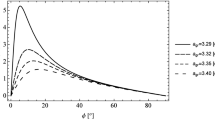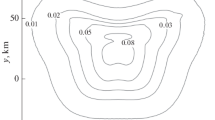Abstract
Cometary impacts on Earth, as comets themselves, especially aperiodic ones, have been much less studied compared to asteroids. Nevertheless, despite the rarity of such impacts, they occurred in the past and cannot be ruled out in the near future. Moreover, the impacts of interstellar and, in principle, even intergalactic objects with hyperbolic orbits are possible. One such comet 2I/Borisov has been discovered quite recently. To assess the influence of such objects on Earth, we carried out numerical simulations of the impacts of cometary nuclei with diameters of 1 and 3 km on solid Earth at speeds of 70 and 170 km/s at an angle of 45° to the surface. Modeling was carried out using a hydrodynamic computer code with allowance for thermodynamic properties of a dusty core and shell of a comet and Earth’s crust in solid and molten state. Fluxes of thermal radiation on Earth’s surface were determined based on an approximate solution of the radiation transfer equation, taking into account optical properties of vapors and air. We estimated areas affected by air shock waves, masses of material ejected into the atmosphere and atmospheric pollution, magnitudes of earthquakes, areas of potential fires. The most dangerous direct effect is associated with the possibility of fires in areas that are much larger than both the size of an impact crater and the area of low-velocity ejecta from a crater, ranging in diameter from 3000 km with the minimum of considered impact energies up to 14 000 km with the maximum impact energy. Long-term effects of the impacts are associated with air pollution by fine dispersed ejecta, chemical components, darkening of the atmosphere.





Similar content being viewed by others
REFERENCES
Artemieva, N. and Shuvalov, V., Atmospheric shock waves after impacts of cosmic bodies up to 1000 m in diameter, Meteorit. Planet. Sci., 2019, vol. 54, no. 3, pp. 592–606.
Avilova, I.V., Biberman, L.M., Vorob’ev, V.S., Zamalin, V.M., Kobzev, G.A., Lagar’kov, A.N., Mnatsakanyan, A.Kh., and Norman, G.E., Opticheskie svoistva goryachego vozdukha (Optical Properties of Hot Air), Moscow: Nauka, 1970.
Babrauskas, V., Ignition of wood: A review of the state of the art, J. Fire Prot. Eng., 2002, vol. 12, no. 3, pp. 163–189.
Belcher, C.M., Hadden, R.M., Rein, G., Morgan, J.V., Artemieva, N., and Goldin, T., An experimental assessment of the ignition of forest fuels by the thermal pulse generated by the Cretaceous-Palaeogene impact at Chicxulub, J. Geol. Soc. (London, U. K.), 2015, vol. 172, no. 2, pp. 175–185.
Busarev, V.V., Petrova, E.V., Shcherbina, M.P., Ikonnikova, N.P., Burlak, M.F., and Belinski, A.A., Interstellar comet 2I/Borisov: dust composition from multiband photometry and modelling, Mon. Not. R. Astron. Soc., 2021, vol. 502, no. 2, pp. 1882–1894.
Choukroun, M., Altwegg, K., Kührt, E., Biver, N., Bockelée-Morvan, D., Drążkowska, J., Hérique, A., Hilchenbach, M., Marschall, R., Pätzold, M., Taylor, M.G.G.T., and Thomas, N., Dust-to gas and refractory-to-ice mass ratios of comet 67P/Churyumov-Gerasimenko from Rosetta observations, Space Sci. Rev., 2020, vol. 216, no. 3, artic. 44.
Cordiner, M.A., Milan, S.N., Biver, N., Bockelée-Morvan, D., Roth, N.X., Bergin, E.A., Jehin, E., Remijan, A.J., Charnley, S.B., Mumma, M.J., Boissier, J., Crovisier, J., Paganini, L., Kuan, Y.-J., and Lis, D.C., Unusually high CO abundance of the first active interstellar comet, Nat. Astron., 2020, vol. 4, no. 9, pp. 861–866.
Fitzsimmons, A., Hainaut, O., Meech, K.J., et al., Detection of CN gas in interstellar object 2I/Borisov, Astrophys. J., Lett., 2019, vol. 885, no. 1, Paper ID L9.
Glasstone, S. and Dolan, P.J., The Effects of Nuclear Weapons, 3rd ed., Washington, U. S. Department of Defense and Department of Energy, 1977.
Glazachev, D., Podobnaya, E., Popova, O., Svetsov, V., Shuvalov, V., and Artemieva, N., Scaling relations for shock wave effects from the impacts of cosmic objects with diameters from a few meters to 3 km, in Trigger Effects in Geosystems, Kocharyan, G. and Lyakhov, A., Eds., Cham: Springer, 2019, pp. 475–486.
Grishin, A.M., Golovanov, A.N., and Medvedev, V.V., On the ignition of a layer of combustible forest materials by light radiation, Combust., Explos., Shock Waves, 1999, vol. 35, no. 6, pp. 618–621.
Hui, M.-T., Ye, Q.-Z., Föhring, D., Hung, D., and Tholen, D.J., Physical characterization of interstellar comet 2I/2019 Q4 (Borisov), Astron. J., 2020, vol. 160, no. 2, Paper ID 92.
Jenniskens, P., Popova, O.P., Glazachev, D.O., Podobnaya, E.D., and Kartashova, A.P., Tunguska eyewitness accounts, injuries, and casualities, Icarus, 2019, vol. 327, pp. 4–8.
Jewitt, D. and Luu, J., Initial characterization of interstellar comet 2I/2019 Q4 (Borisov), Astrophys. J., Lett., 2019, vol. 886, no. 2, Paper ID L29.
Jewitt, D., Hui, M.-T., Kim, Y., Mutchler, M., Weaver, H., and Agarwal, J., The nucleus of interstellar comet 2I/Borisov, Astrophys. J., Lett., 2020, vol. 888, no. 2, Paper ID L23.
Khazins, V.M., Shuvalov, V.V., and Svettsov, V.V., The seismic efficiency of space body impacts, Sol. Syst. Res., 2018, vol. 52, no. 6, pp. 547–556.
Koeberl, K. and Ivanov, B., Asteroid impact effects on Snowball Earth, Meteorit. Planet. Sci., 2019, vol. 54, no. 10, pp. 2273–2285.
Kosarev, I.B., The optical properties of vapors of matter of cosmic bodies invading the Earth atmosphere, High Temp., 2009, vol. 47, no. 6, pp. 777–787.
Kuznetsov, N.M., Termodinamicheskie funktsii i udarnye adiabaty vozdukha pri vysokikh temperaturakh (Thermodynamic Functions and Shock Adiabats of Air at High Temperatures), Moscow: Mashinostroenie, 1965.
Lamy, P.L., Toth, I., Fernández, Y.R, and Weaver, H.A., The sizes, shapes, albedos, and colors of cometary nuclei, in Comets II, Festou, M., Keller, H.U., and Weaver, H.A., Eds., Tucson: Univ. Arizona Press, 2004, pp. 223–264.
Meech, K.J., Weryk, R., Micheli, M., Kleyna, J.T., Hainaut, O.R., Jedicke, R., Wainscoat, R.J., Chambers, K.C., Keane, J.V., Petric, A.P., Denneau, L., Magnier, E., Berger, T., Huber, M.E., and Flewelling, Y., et al., A brief visit from a red and extremely elongated interstellar asteroid, Nature, 2017, vol. 552, pp. 378–381.
Melosh, H.J., Impact Cratering: A Geologic Process, Oxford: Oxford Univ. Press, 1989.
Melosh, H.J., A hydrocode equation of state for SiO2, Meteorit. Planet. Sci., 2007, vol. 42, no. 12, pp. 2079–2098.
Mills, M.J., Toon, O.B., Lee-Taylor, J., Robock, A., Multidecadal global cooling and unprecedented ozone loss following a regional nuclear conflict, Earth’s Future, 2014, vol. 2, no. 4, pp. 161–176.
Morgan, J.V., Artemieva, N., and Goldin, T., Revisiting wildfires at the K-Pg boundary, J. Geophys. Res.: Biogeosci., 2013, vol. 118, no. 4, pp. 1508–1520.
Paradowski, M.L., A new method of determining brightness and size of cometary nuclei, Mon. Not. R. Astron. Soc., 2020, vol. 492, no. 3, pp. 4175–4188.
Pierazzo, E. and Melosh, H.J., Melt production in oblique impacts, Icarus, 2000, vol. 145, pp. 252–261.
Popova, O.P., Jenniskens, P., Emel’yanenko, V., Kartashova, A., Biryukov, E., Khaibrakhmanov, S., Shuvalov, V., Rybnov, Y., Dudurov, A., Grokhovsky, V.I., Badyukov, D.D., Yin, Q.-Z., Gural, P.S., Alberts, J., Gravnik, M., et al., Chelyabinsk airburst, damage assessment, meteorite recovery, and characterization, Science, 2013,vol. 342, no. 6162, pp. 1069–1073.
Robertson, D.K. and Gisler, G.R., Near and far-field hazards of asteroid impacts in oceans, Acta Astronaut., 2019, vol. 156, pp. 262–277.
Robock, A., Oman, L., and Stenchikov, G.L., Nuclear winter revisited with a modern climate model and current nuclear arsenals: Still catastrophic consequences, J. Geophys. Res., 2007, vol. 112, Paper ID D13107.
Shuvalov, V.V., Multi-dimensional hydrodynamic code SOVA for interfacial flows: Application to the thermal layer effect, Shock Waves, 1999, vol. 9, no. 6, pp. 381–390.
Shuvalov, V.V., Ejection of sea water induced by marina target asteroidal impacts, in Sb. nauchn. tr. IDG RAN: Dinamicheskie protsessy v geosferakh, vyp. 10 (Collect. Pap. IDG RAS: Dynamic Processes in Geospheres, vol. 10), Moscow: GEOS, 2018, pp. 126–131.
Shuvalov, V.V. and Artemieva, N.A., Numerical modeling of Tunguska-like impacts, Planet. Space Sci., 2002, vol. 50, no. 2, pp. 181–192.
Shuvalov, V.V. and Trubetskaya, I.A., Numerical modeling of the formation of the Eltanin submarine impact structure, Sol. Syst. Res., 2007, vol. 41, no. 1, pp. 56–64.
Shuvalov, V.V., Svettsov, V.V., Artem’eva, N.A., Trubetskaya, I.A., Popova, O.P., and Glazachev, D.O., Asteroid Apophis: Evaluating the impact hazards of such bodies, Sol. Syst. Res., 2017a, vol. 51, no. 1, pp. 44–58.
Shuvalov, V., Svetsov, V., Popova, O., and Glazachev, D., Numerical model of the Chelyabinsk meteoroid as a strengthless object, Planet. Space Sci., 2017b, vol. 147, pp. 38–47.
Simms, D.L. and Law, M., The ignition of wet and dry wood by radiation, Combust. Flame, 1967, vol. 11, no. 5, pp. 377–388.
Svettsov, V.V., Explosions in the lower and middle atmosphere: The spherically symmetrical stage, Combust., Explos., Shock Waves, 1994, vol. 30, no. 5, pp. 696–707.
Svetsov, V. and Shuvalov, V., Thermal radiation from impact plumes, Meteorit. Planet. Sci., 2019, vol. 54, no. 1, pp. 126–141.
Svettsov, V.V., Shuvalov, V.V., and Popova, O.P., Radiation from a superbolide, Sol. Syst. Res., 2018, vol. 52, no. 3, pp. 195–205.
Thompson, S.L. and Lauson, H.S., Improvements in the Chart D Radiation-Hydrodynamic CODE III: Revised Analytic Equations of State, Report no. SC-RR-71 0714, Albuquerque: Sandia National Laboratory, 1972.
Toon, O.B., Turco, R.P., Covey, C., and Zahnle, K., Environmental perturbations caused by the impacts of asteroids and comets, Rev. Geophys., 1997, vol. 35, no. 1, pp. 41–78.
Turtle, E. and Pierazzo, E., Thickness of an Europan ice shell from impact crater simulations, Science, 2001, vol. 294, no. 5545, pp. 1326–1328.
Weiler, M., Rauer, H., Sterken, C., Cometary nuclear magnitudes from sky survey observations, Icarus, 2011, vol. 212, pp. 351–366.
Zel’dovich, Ya.B. and Raizer, Yu.P., Fizika udarnykh voln i vysokotemperaturnykh gidrodinamicheskikh yavlenii (Physics of Shock Waves and High-Temperature Hydrodynamic Phenomena), Moscow: Nauka, 1966. (English translation: Zel’dovitch, Ya.B. and Raizer, Yu.P., Physics of Shock Waves and High-Temperature Hydrodynamic Phenomena, New York: Academic Press, 1967.)
ACKNOWLEDGMENTS
The authors are grateful to the reviewers B.A. Ivanov and V.V. Busarev for their careful reading the article, valuable comments and advice.
Funding
The study was conducted under the state assignment of the Ministry of Science and Higher Education of the Russian Federation (theme AAAA-A17-117112350016-2).
Author information
Authors and Affiliations
Corresponding authors
Rights and permissions
About this article
Cite this article
Svetsov, V.V., Shuvalov, V.V. Assessments of Aperiodic Comet Impact Effects on Earth. Izv., Phys. Solid Earth 57, 768–778 (2021). https://doi.org/10.1134/S1069351321050190
Received:
Revised:
Accepted:
Published:
Issue Date:
DOI: https://doi.org/10.1134/S1069351321050190




